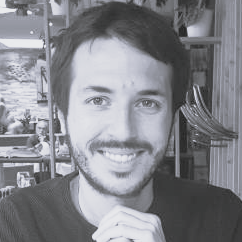 |
INTERVIEW - ELLIOTT BARNES, FOUNDER OF ELLIOTT BARNES INTERIORS: "I TRY TO MAKE THE HEART BEAT, TO PROVOKE AN EMOTION" (France)
A native of the United States who became a naturalised French citizen seven years ago, Elliott Barnes' creativity and sensibility take him across the globe, in the service of discreet, metamorphic luxury. |
Category: Europe - France - Interviews and portraits
- Suppliers
- Providers - Interviews
Interview made by Christopher Buet on Thursday 27 July 2023
Immersing yourself in the world of Elliott Barnes is an experience, a journey of subtlety and restraint. The American-French artist's style requires a great deal of thought, because it is not immediately obvious. As he said, it is a "calm extravagance", a play of contrasts that is never completely smooth, where he takes a back seat to a project to better magnify its contours and character, distilling his contribution only in a few selected details that only the most attentive will be able to identify.
To enjoy a place or object that has passed through the artist's hands, you have to be able to let go and feel its volumes, organisation and textures. These textures are one of the hallmarks of his protean work, which is constantly renewed according to the project that drives it.
For Ruinart, for example, the Parisian by adoption had fun designing the new tasting room using only the materials on site, from the glass in the bottles to the wood in the barrels and the stone from the quarries, while in Germany, he turned the Ritz-Carlton in Wolsfburg into an evocation of Volkswagen, as the Autostadt site is its house.
Elliott Barnes doesn't fit into any particular box, moving from one world to another as if to escape the codes. A legacy of his dual culture, he grew up in Los Angeles but studied at the French lycée from the age of 4, but also of his training alongside Andrée Putman.
With a soft and welcoming voice, the double bass player and jazz fan took the time to lose himself in the meanders of his creativity with the Journal des Palaces, with the background rhythm of his curiosity and humility that guide him.Journal des Palaces: What is your background? What have your collaborations with Andrée Putman brought you?Elliott Barnes: It all started when I arrived in France at Andrée Putman's office, which was called Ecart International. We worked on a few exceptional hotel projects, including one with eight suites in Japan. Then she left Ecart to set up her own agency (Studio Putman) and asked me to become a partner and director of the design office. We had the opportunity to work for the Ritz-Carlton brand in Germany on Volkswagen's Autostadt site. It was a 172-key hotel. We've also done some very high quality residential projects.
When I set up my agency in 2004, I was called back by the Autostadt team to revisit the hotel. It's been four great years working for a car manufacturer that brings notions of practicality into a world of luxury to fine-tune the design. More recently, I worked withthe Montesquieu, an independent 18-suite hotel in Paris. There have been many other projects too, such as the tasting centre for Ruinart or with Christofle...Why is it interesting not just to be involved in hotel projects?I think I have to challenge myself. Diversity allows me to build bridges between different subjects and to bring in new ideas. It's an interesting breathing space that allows me to bring something different to my clients.Andrée Putman championed creativity and, above all, curiosity. Did she inspire your taste for project diversity?From a very early age, in the United States, my parents pushed me into a wide variety of activities. I was very curious, I drew a lot, furniture but also boats, I played music, I danced... All these notions of stimulation in very different environments were part of me.
When I came to Ecart International, Andrée's work made sense to me. She mixed different eras, looking at people like Jean-Michel Franck (editor's note: French decorator from the Art Deco period), creating while observing antique and traditional furniture. His approach was very varied. I knew straight away that she was the person I wanted to learn the interior design profession from.In fact, you say that knowledge of history frees creativity, and you pass this idea on to your staff. Why do you do this?I need the fresh eyes of the new generation, their approach to feed me and challenge what I've learned. We're a design office, not a school. I don't dictate like a teacher, but we are in a permanent masterclass with this notion of exchange and transmission.
When I travel, I spend a lot of time taking photos and sending them around to get people thinking. I was recently in Mantua and sent photos of the Basilica of Saint Andrew, built in 1472, so that my colleagues could see the Renaissance proportions. I also tell them to go and see the work of Otto Wagner, Adolf Loos and Paul Williams, or to look at how Paris is designed.
In luxury and exceptional projects, beauty is linked to function and practicality. When you open the bonnet of a Ferrari, the engine is beautiful and perfectly designed, but nothing is free. It's the same as the work of renowned architects.Are beauty and utility part of the same coin for you?You can't have one without the other. I had the opportunity to take my son to Palladio's Villa Rotonda (editor's note: designed between 1566 and 1571). The whole construction of this villa, which is a square set in a circle, is quite perfect because all the circulation of employees takes place in corners. If you dine in the central hall, the service arrives and leaves without you seeing a thing. We're in the Renaissance, and we already have this notion of marriage between the functional and the aesthetic.What is your vision of luxury?Luxury isn't flashy, it's invisible, very subtle, and delicate. Above all, luxury isn't democratic, it's made for you. Every time luxury opens up, it recontracts and escapes into the exclusive. In fact, I prefer to talk about exclusivity and exception rather than luxury.How would you define your style and the philosophy behind your work?I create interiors that are canvases on which the moments of a lifetime can take place. It's a sort of delicate and subtle balance between the need to exist, to draw volumes, to create passages and to work with light, and the need to step aside to ensure that you spend a better moment on a piece of furniture that I've designed or in an interior that I've imagined.
I'm all about support and "made for you". For example, what I did for Ruinart was very detailed and made for them, and has nothing to do with what I want to offer Billecart-Salmon, where I'm looking for other notes and accords. I'm only there to help express and reveal a character. Imposing a look is anti-luxury. Exceptional and unique things just listen and create an echo.
In terms of aesthetics, I like to confront textures, light and shade. When everything is smooth and perfect, it's a bit boring. I try to make the heart beat, to provoke an emotion, to evoke curiosity.How do your employees inspire you?We're dealing with a digital generation, who have mastered digital tools that give them a different way of looking at space. Today, they are much more open and have much more information at their disposal. They work faster and that means we can go further. I can take more time in my reflections because the speed of execution will be there afterwards.How do you work with hoteliers? How far do you take your thinking and collaboration?It's different every time, depending on the context and the hotelier. If the brand is an owner, it will come with a set of specifications, and I'll have to find support and create a story based on the location and the programme.
If I'm working with an owner who has asked a brand to exploit its assets, that's a different debate, because the relationship will be more with the owner than with the hotelier, as was the case with the Ritz-Carlton, which was the operator and Autostadt the owner. Autostadt provided me with his way of thinking to create cars.
When I work with an owner-manager, it's even different, because then we're dealing with something very specific and unique. We're going to express not only a theme but also the owner's desire to exist through the project. For me, an owner-operated hotel is like designing a big house, except that there are 75 rooms.Is it fair to say that they come up with a kind of script for you to direct?For a hotel, I imagined two friends who hadn't seen each other for 15 years and who had arranged to meet in Paris. I told the story of their friendship and how they were going to arrive at the hotel, how they were going to be received. I worked on the architecture but also on the welcome dimension. It allows you to dream, to imagine things that someone else wouldn't have seen. It can help us to realise whether we are right or wrong with the project, to go ahead in one case and correct it in another.How do you see interior design in luxury hotels evolving over the years?We're in a period of great ostentation, where people want to show off. So we have to find spaces that speak volumes, even though I think there's still space for things that are "rather quiet and discreet". I've also seen a real focus on service and the way people are received.You're American and live in Paris. How does this influence your approach to the projects you work on, and how have you been influenced by French culture?I took French nationality about seven years ago, but at the age of four my parents enrolled me in the French school in Los Angeles, where I stayed for ten years. The training I had in the United States taught me to be practical, to make things that work and that will last over time. It also taught me how to get to the bottom of a design, because through our design, we give an instruction.
I took this base to France where I met 3rd or 4th generation craftsmen who told me not to conceptualise from the inside out but to be content with the outside because they would take care of the inside.What demands do hotels make of your work?Nobody wants to be a guinea pig. They're no longer interested in the ephemeral. They want beautiful things that will last and work. When I arrived in France, we were very concerned about beauty. But not any more. There's been a real change. Today, customers are less forgiving of the choice of materials. We are held responsible for what we imagine.You like to use unusual or unusual materials. How do you choose your materials over and above the specifications imposed on you?It's often the project that dictates the choice of material. I'm thinking of the project to renovate Ruinart's tasting centre. The nature of the house, the winemaking process, its simplicity and authenticity gave me the idea of telling the president that everything I needed was already on site. For the glass, I had the bottles, for the wood, there were the barrels, the stone was in the chalk quarries, and so on. There was a vocabulary of materials to use.
In Autostadt, at Volkswagen, the way I designed the headboards was strongly influenced by the back seats of some of their cars. We included hidden drawers, things that open in the headboards but also in some of the furniture. We worked with a certain type of leather and stitching to evoke the atmosphere of a car.You advocate a very collaborative approach, like a music group where everyone makes his own contribution. Does this approach come from your love of jazz?I'm a double bass player at heart, and my position is to set the tempo, to frame everyone by providing a rhythmic background against which the others can express themselves. In this way, the double bass enters into discussion and agreement with the other members of the group. In jazz, there's this "questions and answers" technique where the double bassist plays a chord then stops and lets the piano play, which stops to let the trumpet play... Each instrument listens to the other and isn't locked into its own universe.
We live in a community and we need each other. Projects are simply mirrors of life. The idea of doing everything on your own is very sad. Al Pacino used to say, "If you walk into a party and think you're the smartest guy in the room, you're in the wrong room."What has been your most exceptional project in the luxury hotel sector? Why was that?The Ritz-Carlton in Autostadt because I was asked to go beyond a simple renovation and take the notion of luxury as a service to its logical conclusion. It was a major project taking place in Germany, with a very different way of working. This experience enabled me to go and find glass manufacturers in Murano to work with Deutsche Volkstedt, in Dresden, to create pieces designed by an American who spoke French. There was a mixture of three or four cultures. The directors of Autostadt gave me this opportunity because they wanted things designed by me and for them.What are your current projects?We're working on a project with Billecart-Salmon that will be completed in a year's time. We're working on a project for a 10-bedroom chalet for 25 people in Verbier. For this type of house, we have a hotel approach. We're also collaborating on furnishings and lighting. At the same time, we're preparing the scenography for an exhibition at the Jewish Museum (editor's note: from 13 October 2023 to 18 February 2024) in New York.What would be your dream project?I'd love to design the inside of a plane, a church or an isolated resort in the desert.What do you think will be the hotel trends in the years to come?We're moving towards greater individualisation. People are travelling more and more and are increasingly demanding. They are constantly looking for something different, more exclusive and unique. They want to say: "No one has done this before me". That forces us to look further and further and I love that.
|
|







